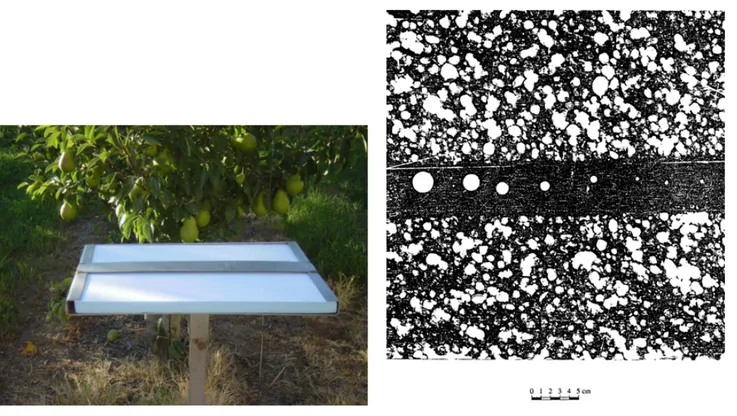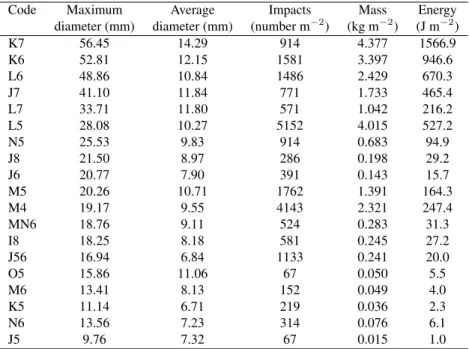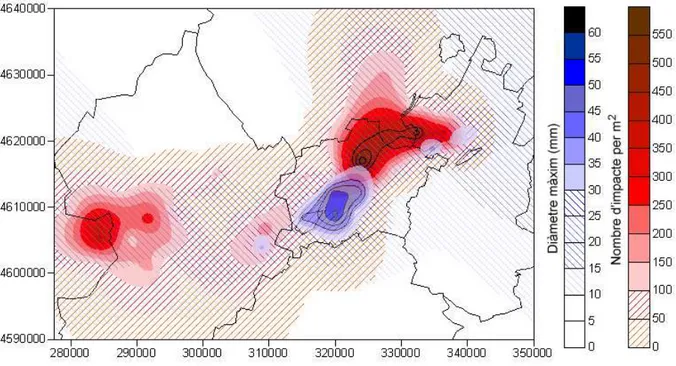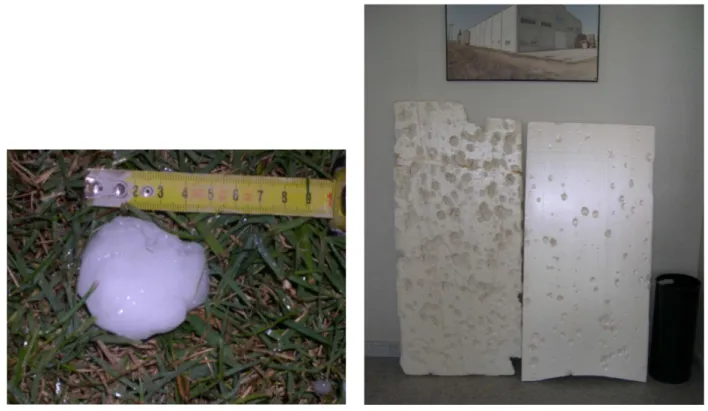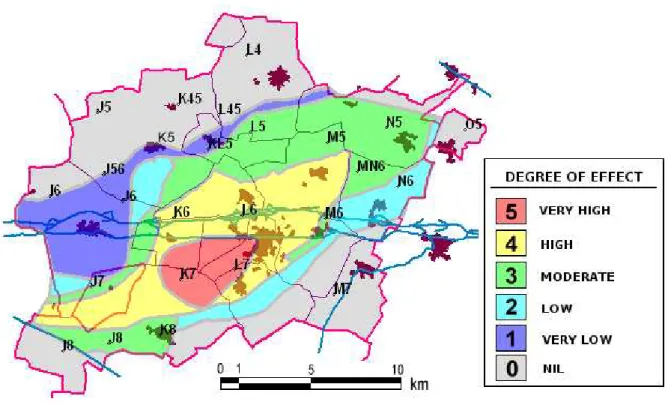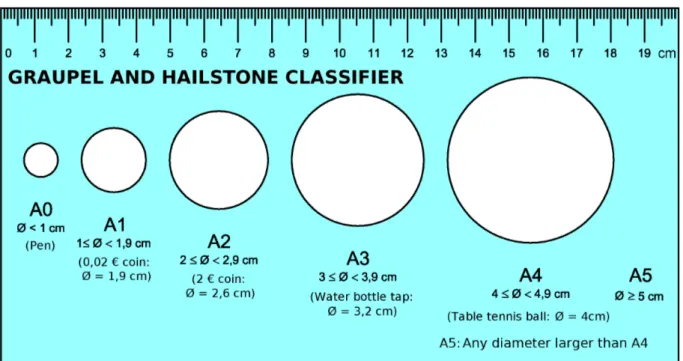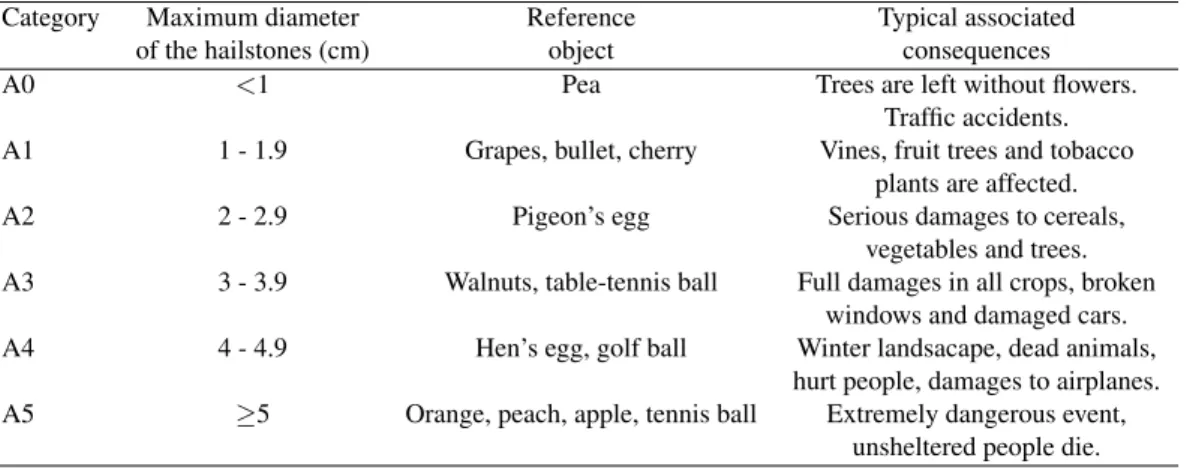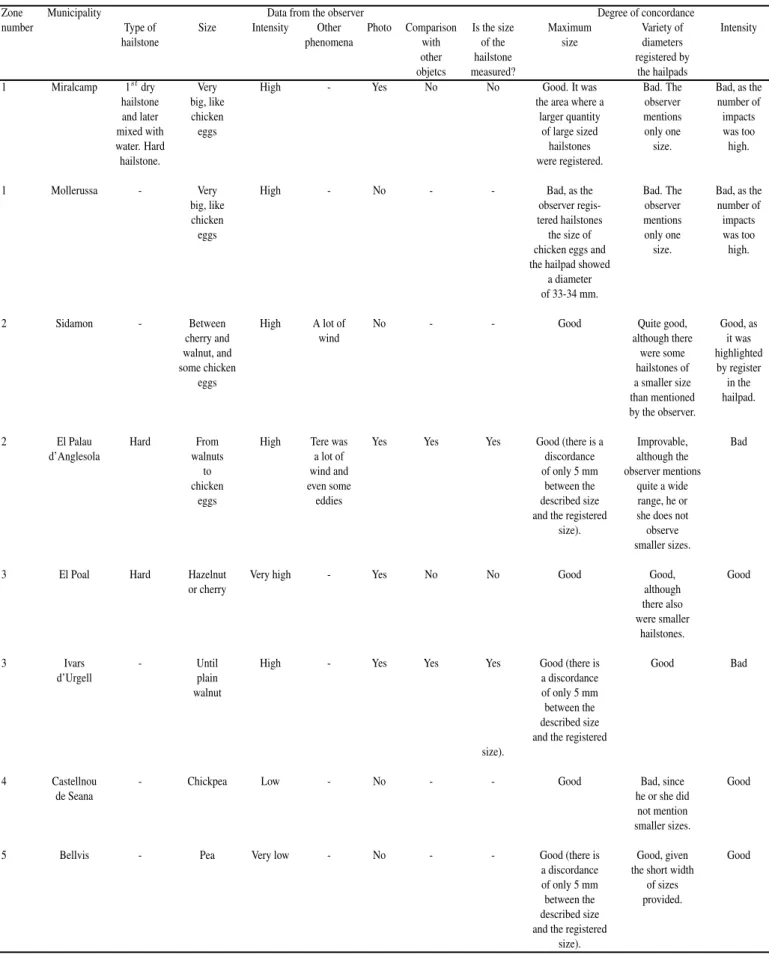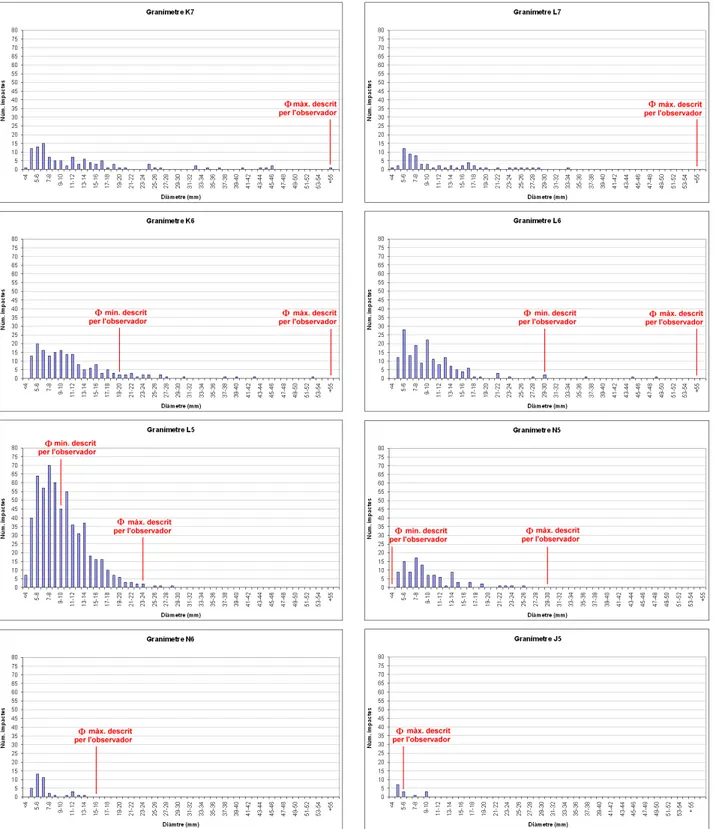Tethys, 6, 67–79, 2009
Journal of Weather & Climate of the Western Mediterranean www.tethys.cat
ISSN-1697-1523 eISSN-1139-3394
DOI:10.3369/tethys.2009.6.05
Journal edited by
ACAM
(Associaci´o Catalana de Meteorologia)
Study of the hailstorm of 17 September 2007 at the Pla
d’Urgell. Part one: fieldwork and analysis of the hailpads
C. Farnell1, M. Busto1, M. Aran1, A. Andres1, N. Pineda1and M. Tor`a2 1
Servei Meteorol`ogic de Catalunya. C/Berl´ın 38-36, 4a planta. 08029 Barcelona 2Agrupaci´o de Defensa Vegetal de les Terres de Ponent
Received: 12-III-2009 – Accepted: 4-VIII-2009 –Translated version
Correspondence to:maran@meteo.cat
Abstract
The plain of Lleida is a farming area with about 200,000 ha of crops. On 17 September 2007 a hailstorm hit 889 ha of fruit crops, especially the area of the Pla d’Urgell (Urgell Plain). That hailstorm was the largest since 1990, according to the data collected by the Agrupaci´o de Defensa Vegetal de les Terres de Ponent (ADV-TP) (Group for the protection of plants in the Terres de Ponent): hailstones larger than 5 cm in diameter and 81 hailpads hit (the average in the Lleida area in September is 7 hailpads affected). A mesoscale convective system originating in the Iberian Range was reactivated when arriving to Catalonia, resulting in a hailstorm that was particularly virulent and affected a wide area (the second part of the study focuses on the synoptic and mesoscalar study). This first part presents the analysis of the data from the network of hailpads managed by the ADV-TP and the information obtained from observers in the affected area. The conclusion drawn from this analysis is that the location of the largest hailstones does not match with the more heavily impacted area. Regarding the qualitative information obtained from the contributors, the affected area is similar to that obtained from the hailpads. However, it should be noted from the comparative study between both sources of information that observers tend to perceive only the larger hailstones when there is a mixture of diameters. To conclude, a number of recommendations are presented in order to maximize the objectivity of the reports presented by the observers.
Key words:hail, hailpad, diameter, observers, ruler
1 Introduction
Hailstorms and graupel storms are some of the most fearsome meteorological phenomena for agriculture, espe-cially for vegetable crops and fruit trees. A hailstorm can completely ruin the harvest of an entire year in just a few minutes.
Spain is the European country with the greatest losses in agriculture caused by hail. Between 1991 and 2001, insurance companies paid more than 2200 M C in all of Spain in compensation for crop damage caused by hail, half of which went to the central area of the Ebre valley (S´anchez et al., 2003). According to Agroseguros (personal communication), in 2007 nearly 12.5 M C were paid in compensation for crop damage caused by hail in Lleida.
The Lleida plain is an agricultural area with about 200.000 ha of crops. The impact of hailstorms in this area is significant, and theAgrupaci´o de Defensa Vegetal de les Terres de Ponent (ADV-TP) (Group for the protection of plants in the Terres de Ponent) (ADV, 2001; S´anchez et al., 2007) conducted some hail prevention campaigns in Lleida in the period 1976-2004. Their impact is also evidenced by the number of studies done in the area (e. g. Pascual, 2002; Tudur´ı et al., 2003; Ceperuelo et al., 2006; and Aran et al., 2007).
C. Farnell et al.:Hailstorm of 17/09/2007 at the Pla d’Urgell, part one
Figure 1.Location of the study area: Iberian Peninsula (left), Catalonia (middle) and Pla d’Urgell area (right).
Table 1. Surface of damaged fruit in the Lleida area (in ha) and percentage of affected surface for each crop. Source: DAR (Departament d’Agricultura, Alimentaci´o i Acci´o Rural) (Department of Agriculture, Food and Rural action).
Municipality Apples Average % Pears Average % Peaches Average %
orcomarca (ha) (ha) (ha) (ha) (ha) (ha)
Pla d’Urgell 207 More than 50% 63 More than 50% 4 More than 50%
Agramunt, Castellser`a,
La Fuliola, Puigverd 117 More than 50% 3 More than 50% 2 More than 50%
d’Agramunt and Tornabous
Juneda, Puiggr`os, 43 More than 50% 11 More than 50% 4 More than 50%
Borges Blanques Soses, Alcarr`as,
Lleida, Montoliu, 235 More than 50% 85 More than 50% 115 More than 50%
Alam´us, Sudanell
TOTAL 602 162 125
southwest of Lleida. The presence of a trough at high levels associated to a low pressure system in the north of the Iberian Peninsula is a recurring situation in hailstorms in Lleida (over 38% of days according to the climatology of Pascual, 2002). On September 17 the formation of a mesoscale convective system began in the southwest of the Iberian Range at 09:00 U.T. and moved to the northeast. Convective centers were reactivated upon their arrival in Catalonia (14:00 U.T.). The most intense part of the episode took place in the area of the Pla d’Urgell (Figure 1) between 14:54 U.T. and 15:00 U.T. The meteorological analysis of the episode is described in detail in the second part of this work (Pineda et al., 2009).
This hailstorm was particularly virulent and extensive. Six people visited the primary care center in Mollerussa with minor bruises. In addition, some street furniture and vehicles were affected; some of them were virtually destroyed. Ac-cording to the report of theDepartament d’Agricultura, Ali-mentaci´o i Acci´o Rural(DAR) (Department of Agriculture, Food and Rural action), the most affected crops were late varieties of apples, pears and peaches. The corn production was less affected by the damages to the crops because the cob was already formed and the grain was in drying phase. As shown in Table 1, there were 889 ha of damaged fruit.
One source of information for the weather service is contributors and amateur meteorologists, and in other situations, the people affected. The difficulty of handling this type of information is a matter of many studies (e. g. Llasat-Botija et al., 2007; Delitala, 2005). These authors have focused on the perception that people have of such situations and their possible bias, mainly due to the influence of the media and historical memory of other episodes. The main objective of this work, besides characterization of the type of precipitation and its distribution, is to make a first evaluation of the reliability of the information provided by witnesses in order to improve its quality. For this reason, a comparative study between this data and the records from the registers from the hailpad network has been carried out.
This study followed the dictates of the publication“El manual d’estil”(“The style manual”) of theServei Meteo-rol`ogic de Catalunya(Meteorological Service of Catalonia) (SMC, 2008), which defines graupel as “precipitation of rounded, half transparent ice grains, less than 10 mm in diameter, and hailstones are equal to or greater than 10 mm in diameter”.
C. Farnell et al.:Hailstorm of 17/09/2007 at the Pla d’Urgell, part one
Figure 2.(a) Hailpad used in the ADV-TP. Source: M. Tor`a. (b) Plate with impacts painted in black, prepared for analysis. The central strip presents the impacts done in laboratory to do the calibration. Source: Atmospheric Physics Group,Universidad de Le´on.
until the determination of the affected areas. In section 4 there is a comparative study between the field data and what was measured in the hailpads. In section 5, some indica-tions for improving the information gathering provided by observers are proposed. Finally, the conclusions of the study are presented in section 6.
2 Hailpad network
The data from the hailpad network of the ADV-TP were used to objectively analyze the hailstorm. This section first presents the characteristics of the hailpad network, then an-alyzes the results obtained and, finally, compares them with the statistics elaborated in the period 1990-2007.
2.1 Characteristics of the hailpad network
A hailpad consists of a 30x40x3 cm polystyrene plate with a layer of white exterior paint to prevent spoilage due to weather and solar radiation (Fraile et al., 1992; Schleusener and Jennings, 2006). This plate is positioned approximately 1.5 m above ground (Figure 2a). A portion of the plate is protected from impacts with an iron strip used to make the calibration. After one episode of hail or graupel, the dam-aged plates are sent to be analyzed and replaced with new plates. In the case of the ADV-TP, the plates are analyzed in the laboratory of the Atmospheric Physics Group of the Uni-versidad de Le´on(University of Le´on). In the laboratory, the
impacted plates are painted with black graphic paint (Fig-ure 2b) to facilitate the meas(Fig-urement of the size and depth of the marks. Other parameters, such as diameter, energy, mass, etc, of the graupel or hail are obtained from this oper-ation (Palencia et al., 2007).
In the Lleida plain, the ADV-TP created a network of hailpads with a density of 4 x 4 km. This pattern of a hail-pad each 16 km2 means a total of 170 hailpads distributed
in the control area (Figure 3). This hailpad distribution and quantity responds to three criteria (Fraile et al., 1992):
• Average surface affected by hail in the ten years prior to the installation of the network.
• Need to obtain 10 affected hailpads in each significant hailstorm to be able to carry out its study and compari-son.
• Network maintenance criteria.
2.2 Analysis of the data from the hailpads in the Pla d’Urgell
This study is focused on the Pla d’Urgell area, where there are 18 hailpads (Figure 3). The figures of several vari-ables are obtained from these hailpads, which let us know the characteristics of the hailstone: diameter, number of impacts per m2; this refers to the intensity of the hailstorm, mass
C. Farnell et al.:Hailstorm of 17/09/2007 at the Pla d’Urgell, part one
Figure 3. Hailpad network of the ADV-TP: consists in 170 hailpads distributed in the different comarques (administrative divisions) (boundaries in pink) of Segri`a (Lleida), La Noguera (Balaguer), Pla d’Urgell (Mollerussa), l’Urgell (T`arrega) and Les Garrigues (Les Borgues Blanques). The Pla d’Urgell, where 18 hailpads of the network are located, is highlighted in purple. The network of main roads in the area are in blue.
Table 2. Hailpad code, maximum diameter (mm), impacts (number m−2), mass (kg m−2) and energy (J m−2) of the impacts per each hailpad of the Pla d’Urgell.
Code Maximum Average Impacts Mass Energy
diameter (mm) diameter (mm) (number m−2) (kg m−2) (J m−2)
K7 56.45 14.29 914 4.377 1566.9
K6 52.81 12.15 1581 3.397 946.6
L6 48.86 10.84 1486 2.429 670.3
J7 41.10 11.84 771 1.733 465.4
L7 33.71 11.80 571 1.042 216.2
L5 28.08 10.27 5152 4.015 527.2
N5 25.53 9.83 914 0.683 94.9
J8 21.50 8.97 286 0.198 29.2
J6 20.77 7.90 391 0.143 15.7
M5 20.26 10.71 1762 1.391 164.3
M4 19.17 9.55 4143 2.321 247.4
MN6 18.76 9.11 524 0.283 31.3
I8 18.25 8.18 581 0.245 27.2
J56 16.94 6.84 1133 0.241 20.0
O5 15.86 11.06 67 0.050 5.5
M6 13.41 8.13 152 0.049 4.0
K5 11.14 6.71 219 0.036 2.3
N6 13.56 7.23 314 0.076 6.1
C. Farnell et al.:Hailstorm of 17/09/2007 at the Pla d’Urgell, part one
Figure 4. Spatial distribution of the maximum diameter of the graupel (in mm and scale in blue) and the number of impacts per m2(scale in red).
Figure 4 shows the distribution of the maximum diam-eter and the number of impacts in the Pla d’Urgell area. Re-garding the maximum diameters, the largest were recorded in the southern region. However, the smallest diameter was recorded in the northwest. Nevertheless, if the distribution of the average diameter is analyzed (not shown), the hail-pad with a larger average is located in the northwest. In this area, the hailpad did not register an outstanding maximum diameter but the diameter distribution is around the average values. Regarding intensity, the highest was registered in the hailpad located in the north. In contrast, the lowest values, corresponding to the less affected areas, are recorded in the boundaries of the area, both to the west and to the east. This spatial dissociation between the maximum diameter and in-tensity is similar to that presented in the work of Fraile et al. (1992) for the area of Le´on and Zamora.
In the spatial distribution of mass and energy (not shown) it was observed that the areas with higher values for these variables corresponded to the locations where higher values were recorded both for maximum diameter and for number of impacts. This is because both mass and energy depend on the diameter and number of impacts.
One factor that has to be taken into consideration when analyzing hailpads is the fact that when large diameters are recorded, the number of small hail impacts are underesti-mated, since the latter can be covered by those of larger di-ameter (Dessens et al., 2007). On the other hand, there is also an underestimation in the case of large diameter hail-stones, as the probability of impact on the hailpad is very small (Smith and Waldvogel, 1989; Bardsley, 1990; Fraile et al., 1999).
2.3 Climatology of the hailstorms
In the Lleida plain, September is not very affected by hailstorms, as the average of this phenomenon during the pe-riod between 1995 and 2007 is one day (the yearly average is 12 days). The month with a higher frequency of hailstorms or graupel storms is May, which has three days, followed by April, with two days. In 2007 there were 17 days of hail-storms: 8 in April, 4 in May and 1 in September.
Generally, hailstorms in September cover a small area, with an average of seven hailpads affected. Until 2007, the maximum number of hailpads impacted in September was 26 (2002). Regarding absolute values, the average of impacted hailpads per hailstorm day was 12, and the maximum of hail-pads in a single day was 41, which occurred twice - once on 17 April 2008.
On 17 September, 81 hailpads were affected, which means 30% of the affected hailpads in 2007. Thus, in a sin-gle day there were as many hailpads affected as in May and June 2007, which is a sign of the magnitude of the range of the hailstorm. Regarding the size of the hail, in September it is usually small; 70% are cases of graupel. During the day analyzed, the hailstones collected were larger than 5 cm in diameter (Figure 5a).
3 Fieldwork
C. Farnell et al.:Hailstorm of 17/09/2007 at the Pla d’Urgell, part one
Figure 5. (a) Hailstone of 5 cm in diameter from 17 September 2009. Source: F. Farnell. (b) Expanded polystyrene plates from factory premises in the area. Source: Comolsa, S.A..
Table 3.Degree of impact according to measurement and intensity.
Category Measure Intensity Degree of impact
5 Chicken eggs High Very high
4 Cherry to chicken egg High - very high High
3 Cherries and walnuts High Moderate
2 Chickpeas and hazelnuts Low Low
1 Lentils, peas and chickpeas Low Very low
0 Not affected Not affected Nil
First of all, a network of observers or contributors might be used, that need to be close enough in proximity to cover the whole area of study, as S´anchez et al. (1996) did. If the con-tributors are not located close enough to each other, data from insurance companies could be used, as they provide informa-tion about large hail that provoked damages (Dessens, 1986). If the necessary resources are available, and they are pro-tected by the data privacy law, it is possible to call the people affected by a hailstorm, according to the radar images, in real time (Smith et al., 2006).
Such resources where not available for this work. To get complementary information, we proceeded as follows: (i) The affected area was determined from the meteorologi-cal data taken from the media information. (ii) The places to be visited where selected, starting with the most affected and ending with the least damaged. (iii) We set up visits with the affected people via phone. (iv) Finally, the field
visit was carried out, with face-to-face interviews with the witnesses.
During those visits, we obtained the description of the events by people who were directly affected: evolution of the storm, kind of precipitation, maximum size of the hail-stones, variety of diameters, intensity of the hailstorm, other relevant meteors observed during the hailstorm and damages. Additionally, some material of interest was compiled, such as photographs or material affected by the impacts (Figure 5b). In all, 11 interviews with affected people were con-ducted, who provided information about practically the en-tire region. On the other hand, other visits were made to obtain additional information. This field study was carried out a few days after the hailstorm.
be-C. Farnell et al.:Hailstorm of 17/09/2007 at the Pla d’Urgell, part one
Figure 6. Areas affected by the hailstorm determined by the fieldwork in the Pla d’Urgell area. Code of the area hailpads (Table 1). Municipality boundaries (purple), main roads (blue) and main population centers (brown).
ginning they were dry hailstones, this is to say, without rain. After a few hailstones fell, they were mixed with rain and thanks to that the hail did not hit so hard.” And about inten-sity (el Poal): “There were no damages in town. But a lot of it fell near Sarc`enit and with a strong intensity.”
Table 3 describes the scale used by the ADV-TP, which incorporates the degree of impact during this episode. Fig-ure 6 shows the spacial distribution of the degrees of impact according to the above-mentioned observations.
4 Comparative study between hailpads and ob-servations
Once the areas were established according to the degree of impact (section 3), a comparison between data from hailpads and observers was performed. To make a comparative study, a diameter for each of the reference objects used by the observers of the ADV-TP network was established.
The comparative study was focused on three variables: the maximum size of the hailstones, the range of diameters recorded and the intensity of the hailstorm. To compare both the data of the maximum size and the range of diameters, it is necessary to know the size of the reference objects used by the observers of the ADV-TP network (see Table 4). To be able to compare the intensity data, the description of the observer was contrasted with the number of impacts recorded in the nearest hailpad (see Annex).
Table 4. Equivalence in mm of the object used to describe the graupel and hail.
Descriptive object Representative measurement (mm)
Chicken egg 40 - 50
Walnut 30
Cherry 15 - 20
Chickpea 15
Hazelnut 10
Lentil 6
Pea 5
Rice 5
C. Farnell et al.:Hailstorm of 17/09/2007 at the Pla d’Urgell, part one
Figure 7.Ruler used to analyze the measurement of the diameter of the graupel and to classify it.
Table 5.Average scoring of the concordance between the description given by the observers and the data from the hailpad per areas. Value 1 indicates maximum concordance.
Variable Area 1 Area 2 Area 3 Area 4 Area 5 Final average
(red) (yellow) (green) (light blue) (navy blue) scoring
Maximum average 2 1 1 1 1 1.25
Variety of diameters 3 2 1 3 1 2
Intensity 3 2 2 1 1 2
larger size than that recorded by the hailpad. It may be an exaggeration of the observer, but it also may be the case that the hailpad did not register precisely the largest diameter (Smith and Waldvogel, 1989).
Regarding diameter, it was detected that the observer mainly takes the size of the larger hailstones and tends to ignore the smaller ones. This fact is understandable because the larger hailstones produce larger damages and remain longer on the ground after falling, since the smaller hail melts faster.
Determination of the intensity (number of impacts per m2) is the weakest point when interpreting the information
obtained from observers, as it is the most subjective variable of all, since there are no standard parameters to define it.
5 Recommendations
Following the line opened by Eduard Fontser`e about recommendations for rural meteorological observers (Fontser`e, 1923) and due to the large amount of existing graphic documentation about this episode, it is necessary
to draft a set of instructions to improve the transmission and subsequent interpretation of the information between ob-server and weather service.
The observer gets information from the consequences of a hailstorm on the crops on a land that they are very famil-iar with. Starting from this premise, we can work to achieve a more useful and accurate transmission of information, im-proving key aspects such as images, channels of communi-cation and the description of the phenomenon.
The images are of great importance, as they show visu-ally the characteristics of the hail and the damages produced by it. When making a photograph it is important to bear some characteristics in mind, such as:
• Keeping track of the date, time and location of where the photograph was taken.
• Placing reference objects of universal dimensions to compare the measurements of the hailstones.
• A ruler may also be used. Find a dark background to increase the contrast.
C. Farnell et al.:Hailstorm of 17/09/2007 at the Pla d’Urgell, part one
Table 6. Classification of the hailstones depending on the diameter, reference objects or consequences according to the ANELFA scale (Dessens et al., 2007). Each category has to be complemented with a + or - sign depending on whether the ground is significantly covered by graupel/hail more than 50% or less than 50%.
Category Maximum diameter Reference Typical associated
of the hailstones (cm) object consequences
A0 <1 Pea Trees are left without flowers.
Traffic accidents.
A1 1 - 1.9 Grapes, bullet, cherry Vines, fruit trees and tobacco
plants are affected.
A2 2 - 2.9 Pigeon’s egg Serious damages to cereals,
vegetables and trees.
A3 3 - 3.9 Walnuts, table-tennis ball Full damages in all crops, broken
windows and damaged cars.
A4 4 - 4.9 Hen’s egg, golf ball Winter landsacape, dead animals,
hurt people, damages to airplanes.
A5 ≥5 Orange, peach, apple, tennis ball Extremely dangerous event,
unsheltered people die.
Table 7. Proposed scale in this study using reference objects. Each category has to be complemented with a + or - sign depending on whether the ground is significantly covered by graupel/hail more than 50% or less than 50%.
Category Maximum diameter of the hailstones (cm) Reference object
A0 <1 Standard pen base (BIC)
A1 1 - 1.9 0.02 C coin (1.875 cm)
A2 2 - 2.9 2 C coin (2.575 cm)
A3 3 - 3.9 Water bottle cap (plastic)
A4 4 - 4.9 Table-tennis ball (4.267 cm)
A5 ≥5 Tennis ball (between 6.5 and 6.858 cm)
Reception of information from contributors in the weather services should be carried out in a more unified and standardized way. It is necessary to announce the established channel and work towards a deft, efficient and easy commu-nication.
Related to description, as mentioned earlier, the ob-server usually provides the size of the largest hailstones, but it would be very useful if he or she could also pro-vide information about the existence of hailstones of smaller sizes.
The key to a good description of the graupel and hail-stones lies in the use of a classification system that is as simple and objective as possible. Today, three scales are mainly used for its classification: the Torro scale (Webb and Meaden, 1986), the GSC scale (Moisselin and Guillande, 2004) and the ANELFA scale (Dessens et al., 2007).
In this study we decided to use the ANELFA scale (Ta-ble 6), as it is also used by the ADV-TP. In it the class cate-gory is determined by the total value of the largest diameter size of the hailstone, measured in cm. In the case this mea-surement is not available, the class is determined from its equivalence to objects such as peas, grapes, pigeon’s eggs, walnuts, chicken eggs and oranges, and the damages pro-voked. Finally, as in the Fujita scale (1971), the
conse-quences and gravity of the damages are used to catalogue the hail.
Nevertheless, this scale is based on a certain degree of subjectivity, since there are different sizes of chicken eggs and grapes. To get a description that is as objective as pos-sible, it is necessary to use reference objects of known and universal size, such as euro coins, table-tennis balls or tennis balls.
For this reason, an adaptation of the ANELFA scale with the standard correspondences with universal common objects is proposed (Table 7).
Finally, we propose providing contributors with a ruler in order to easily categorize the hailstones observed (Fig-ure 7).
6 Conclusions
Fur-C. Farnell et al.:Hailstorm of 17/09/2007 at the Pla d’Urgell, part one
thermore, in the south there were impacts of higher diameter registered and in the north the intensity was higher but the hailstones were smaller in diameter.
From the comparative study we can draw that observers tend to perceive the larger hailstones rather than the smaller graupel or hailstones even if there is a larger number of the latter. However, hailpads underestimate the number of the impacts with a larger diameter. Besides, there are obvious gaps in hailpad detection of the hailstones of a very large di-ameter, due to the low probability of impacting on the plate or an underestimation of the number of small impacts be-cause they are disguised by those with a larger diameter.
There is a need to standardize the data provided by ob-servers in order to be able to properly analyze the scope of the episode and to process them together with the data obtained from hailpads. Both sources of information are complemen-tary. For this purpose, a classification scale for graupel and hailstones in six categories, following the ANELFA scale (Dessens et al., 2007) but with equivalences with known and universal objects is proposed. The use of a ruler with the ref-erence diameters for each category of the ANELFA scale is also proposed.
Acknowledgements. The authors want to thank all contributors and informers from the Pla d’Urgell and surrounding areas who have provided us with information about this episode, and espe-cially to: M. Moi`a, J. Sim´o, F. Farnell, J. Arderiu, X. Coll, N. Risa, J. Llimes, M. Sans, J. Miret, the municipality of Bellcaire d’Urgell and the primary care center of the Pla d’Urgell. To Josep Batll´o, who provided us with the publication Minerva from the map library of theInstitut Cartogr`afic de Catalunya. This work has been done within the framework of collaboration between the Servei Meteo-rol`ogic de Catalunya, theADV Terres de Ponentand the Universi-dad de Le´on. Our special thanks to the whole team in the Atmo-spheric Physics Group of the Universidad de Le´on, especially to Dr. Laura L´opez for her suggestions and, finally, to all the team of contributors of the ADV.
Appendix A
The information used to carry out the comparative study, between the information obtained from the observers and the hailpads closest to the affected area is presented in the annex.
Table A1 has been elaborated to provide an overview of all the information. This table shows the following informa-tion:
• Number of the area. Degree of impact defined in Table 3 of the article.
• Municipality. Municipality of the affected area de-scribed by the observer.
• Data from the observer: type of hailstones, size, inten-sity, other observed phenomena, photographs, compar-ison with other objects and if the hailstones have been measured or not.
• Data from the hailpad. Bar chart that represents the number of impacts depending on the diameter of the
graupel/hail registered in the hailpad closest to the ob-servation point. On the chart the maximum diameter described by the observer is pointed out in red (Fig-ure A1).
C. Farnell et al.:Hailstorm of 17/09/2007 at the Pla d’Urgell, part one
Table A1.Comparative study between the data from the observers and the hailpads.
Zone Municipality Data from the observer Degree of concordance
number Type of Size Intensity Other Photo Comparison Is the size Maximum Variety of Intensity hailstone phenomena with of the size diameters
other hailstone registered by objetcs measured? the hailpads
1 Miralcamp 1stdry Very High - Yes No No Good. It was Bad. The Bad, as the hailstone big, like the area where a observer number of and later chicken larger quantity mentions impacts
mixed with eggs of large sized only one was too
water. Hard hailstones size. high.
hailstone. were registered.
1 Mollerussa - Very High - No - - Bad, as the Bad. The Bad, as the big, like observer regis- observer number of
chicken tered hailstones mentions impacts
eggs the size of only one was too
chicken eggs and size. high. the hailpad showed
a diameter of 33-34 mm.
2 Sidamon - Between High A lot of No - - Good Quite good, Good, as
cherry and wind although there it was
walnut, and were some highlighted
some chicken hailstones of by register
eggs a smaller size in the
than mentioned hailpad. by the observer.
2 El Palau Hard From High Tere was Yes Yes Yes Good (there is a Improvable, Bad d’Anglesola walnuts a lot of discordance although the
to wind and of only 5 mm observer mentions chicken even some between the quite a wide
eggs eddies described size range, he or and the registered she does not size). observe
smaller sizes.
3 El Poal Hard Hazelnut Very high - Yes No No Good Good, Good
or cherry although
there also were smaller
hailstones.
3 Ivars - Until High - Yes Yes Yes Good (there is Good Bad
d’Urgell plain a discordance
walnut of only 5 mm
between the described size and the registered size).
4 Castellnou - Chickpea Low - No - - Good Bad, since Good
de Seana he or she did
not mention smaller sizes.
5 Bellvis - Pea Very low - No - - Good (there is Good, given Good a discordance the short width
of only 5 mm of sizes between the provided. described size
C. Farnell et al.:Hailstorm of 17/09/2007 at the Pla d’Urgell, part one
C. Farnell et al.:Hailstorm of 17/09/2007 at the Pla d’Urgell, part one
References
ADV, 2001: 1976-2001: 25 anys de lluita contra la pedra a les co-marques de Lleida, Agrupaci´o de Defensa Vegetal de les Terres de Ponent, Lleida.
Aran, M., Sairouni, A., Bech, J., Toda, J., Rigo, T., Cunillera, J., and Mor´e, J., 2007: Pilot project for intensive surveillance of hail events in Terres de Ponent (Lleida), Atmos Res,83, 315– 335.
Bardsley, W. E., 1990:On the maximum observed hailstone size, J Appl Meteor,29, 1185–1187.
Ceperuelo, M., Rigo, T., San Ambrosio, I., and Llasat, M. C., 2006: Estudio de dos granizadas severas registradas en 2004 en el Llano de Lleida, Jornadas Cient´ıficas de la Asociaci´on Meteo-rol´ogica Espa˜nola,XXIX.
Delitala, A. M. S., 2005:Perception of intense precipitation events by public opinion, Nat Hazards Earth Syst Sci,5, 499–503. Dessens, J., 1986: Hail in Southwestern France. I: Hailfall
Char-acteristics and Hailstorm Environment, J Climate Appl Meteor,
25, 35–47.
Dessens, J., Berthet, C., and S´anchez, J. L., 2007: A point hail-fall classification based on hailpad measurements: The ANELFA scale, Atmos Res,83, 132–139.
Fontser`e, E., 1923: Instruccions meteorol`ogiques per als observa-toris rurals, Minerva, Col·lecci´o popular dels coneixements in-dispensables publicada pel Consell de Pedagogia de la Manco-munitat de Catalunya, vol. XL, 36 pp.
Fraile, R., Castro, A., and S´anchez, J. L., 1992: Analysis of hail-stone size distributions from a hailpad network, Atmos Res,28, 311–326.
Fraile, R., S´anchez, J. L., Madrid, J. L., Castro, A., and Marcos, J. L., 1999: Some results from the hailpad network in Le´on (Spain): Noteworthy correlations among hailfall parameters, Theor Appl Climatol,64, 105–117.
Fujita, T. T., 1971: Proposed characterization of tornadoes and hur-ricanes by area and intensity, SMRP Research Paper, 91, Univer-sity of Chicago, 42 pp.
Llasat-Botija, M., Llasat, M. C., and L´opez, L., 2007:Natural haz-ards and the press in the western Mediterranean region, Adv Geosci,12, 81–85.
Lozowski, E. P. and Strong, G. S., 1978:On the calibration of hail-pads, J Appl Meteor,17, 521–528.
Moisselin, J. M. and Guillande, R., 2004: Development of inten-sity scales for a wide set of natural phenomena, Annual Meeting Abstracts of the European Meteorological Society, pp.134. Palencia, C., Berthet, C., Massot, M., Castro, A., Dessens, J., and
Fraile, R., 2007: On the individual calibration of hailpads, At-mos Res,83, 493–504.
Pascual, R., 2002: Estudio de las granizadas en el llano de
Lleida, Nota t´ecnica n´um. 3, Centro Meteorol´ogico Territorial de Catalunya, Instituto Nacional de Meteorolog´ıa, http://www. aemet.es/es/divulgacion/varios/detalles/biblioteca tempoweb. Pineda, N., Aran, M., Andres, A., Busto, M., Farnell, C., and Tor`a,
M., 2009:Estudi de la pedregada del 17 de setembre de 2007 al Pla d’Urgell. Segona part: An`alisi meteorol`ogica, Tethys,6. Ramis, C., L´opez, J. M., and Ar´us, J., 1997: Two cases of severe
weather in Catalonia (Spain): an observational study, Meteorol Appl,4, 207–217.
S´anchez, J. L., Fraile, R., Madrid, J. L., Rodr´ıguez, P., and Castro, A., 1996: Crop Damage: The Hail Size Factor, J Appl Meteor,
35, 1535–1541.
S´anchez, J. L., Fern´andez, M. V., Fern´andez, J. T., Tudur´ı, E., and Ramis, C., 2003:Analysis of mesoscale convective systems with hail precipitation, Atmos Res,67-68, 573–588.
S´anchez, J. L., Tor´a, M., L´opez, L., Dessens, J., and
Garc´ıa-Ortega, E., 2007: Physical Evaluation of a Hail
Suppres-sion Project with Silver Iodide Ground Generators in Lleida (Spain), 9th WMO Scientific Conference on Weather Modifica-tion, http://www.wmo.int/pages/prog/arep/wmp/ninth wea mod/ documents/Sanchez Dessens.pdf.
Schleusener, R. A. and Jennings, P. C., 2006:An energy method for relative estimates of hail intensity, Bull Am Meteorol Soc,41, 372–376.
SMC, 2008: Manual d’estil. Interpretaci´o de les informacions me-teorol`ogiques, Publicacions breus del Servei Meteorol`ogic de Catalunya (SMC), Dept. Medi Ambient i Habitatge, Generalitat de Catalunya, http://www.meteo.cat/mediamb xemec/servmet/ pagines/Publicacions/manual estilv2.pdf.
Smith, P. L. and Waldvogel, A., 1989:On determinations of max-imum hailstone sizes from hailpad observations, J Appl Meteor,
28, 71–76.
Smith, T. M., Ortega, K. L., Scharfenberg, K. A., Manross, K. L., and Witt, A., 2006: The Severe Hail Verification Experiment, Amer Meteo Soc, 23rd Conference on Severe Local Storms, st. Louis, MO.
Tudur´ı, E., Romero, R., L´opez, L., Garc´ıa, E., S´anchez, J. L., and Ramis, C., 2003: The 14 July 2001 hailstorm in northeastern Spain: diagnosis of the meteorological situation, Atmos Res, 67-68, 541–558.
Webb, J. D. C. and Meaden, D. M. E. G. T., 1986: The TORRO

